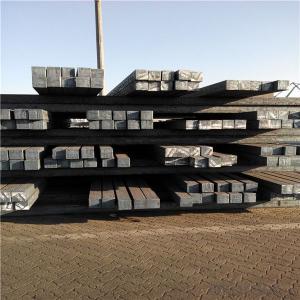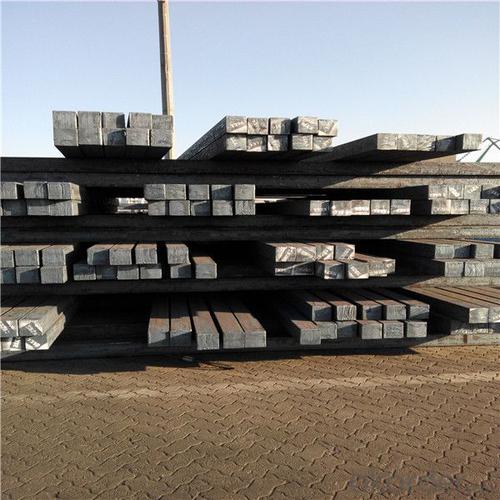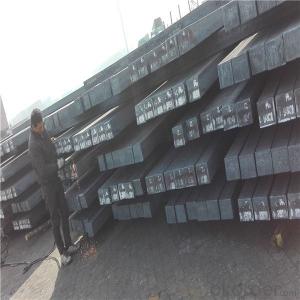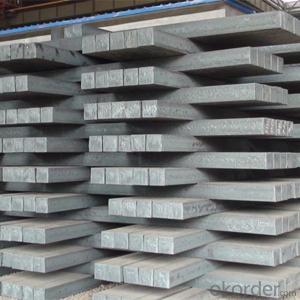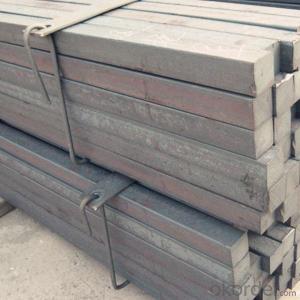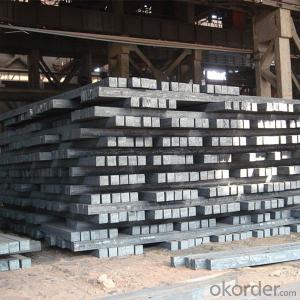STEEL BILLET 120MM/130MM/150MM made in China
- Loading Port:
- Tianjin
- Payment Terms:
- TT OR LC
- Min Order Qty:
- 1000 m.t.
- Supply Capability:
- 17532 m.t./month
OKorder Service Pledge
OKorder Financial Service
You Might Also Like
Specification
Steel billets have distinct characteristics as compared with already furnished steel bars and products.
Billets have a specific grain structure, which enables the metal to be processed more intricately. Steel
billets are also known for their malleability and ductility, especially when exposed to varying temperatures
during shaping and molding.
The billet is mainly divided into two kinds from the shape:
Slab: cross section width and height of the ratio of the larger, mainly used for rolling plate.
Gade:
Standard | C(%) | Mn(%) | S(%) | P(%) | Si(%) |
Q195 | ≤0.12 | ≤0.50 | ≤0.040 | ≤0.035 | ≤0.30 |
Q235 | ≤0.20 | ≤1.40 | ≤0.045 | ≤0.045 | ≤0.35 |
Q275 | ≤0.22 | ≤1.50 | ≤0.045 | ≤0.045 | ≤0.35 |
20MnSi | 0.17-0.25 | 1.2-1.6 | ≤ 0.050 | ≤ 0.050 | 0.40-0.80 |
3SP | 0.14-0.22 | 0.40-0.85 | ≤ 0.050 | ≤ 0.040 | 0.05-0.15 |
5SP | 0.28-0.37 | 0.50-1.00 | ≤ 0.050 | ≤ 0.040 | 0.15-0.30 |
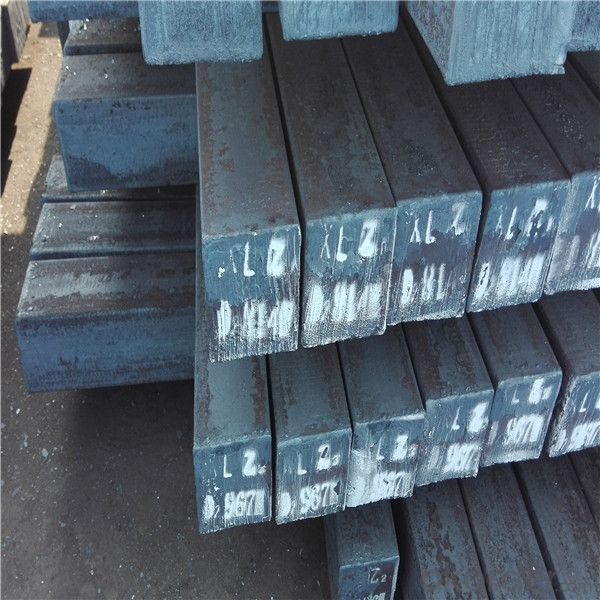
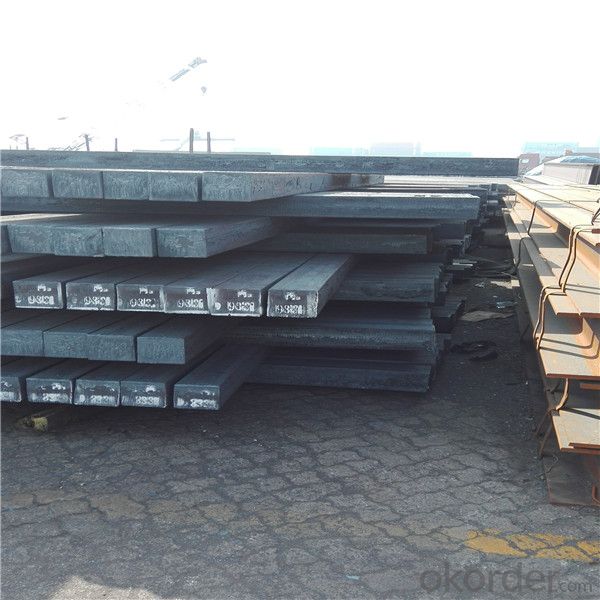

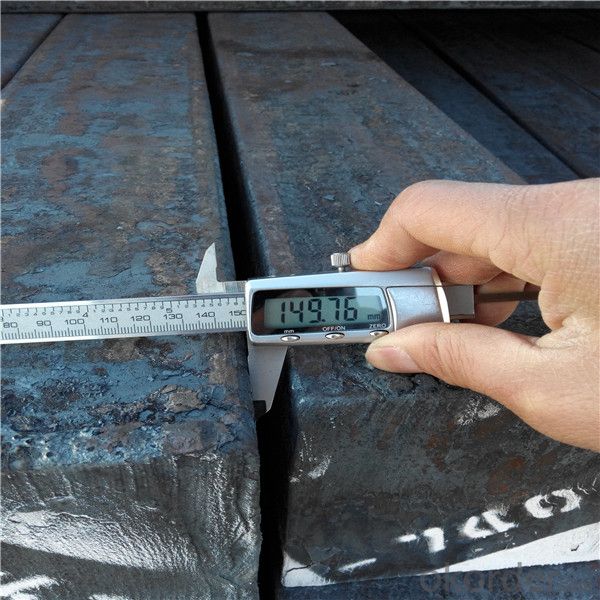
Other Specifications
Size :100mm to 165mm
Length:6~12meters
Squar Tolerance: ±4
Length Tolerance: +100mm
Romboidity/Difference Diagonals: no more than 0.7%
Camber: no more than 1.5%(%)
Twist: no more than 3 degrees per 1 meter length
Our Advantage
* Professional Personnel of Steel Trading
* Strong Steel Industry Background
* Conveniently Geographic Location
Our Commitment
* Sincere, Practical, Efficient and Developing
* High Quality Steel Production
* Competitive Price and Timely Delivery
Packing :
Within 30 days
1.Standard export package
2.In bundles with steel strips
3.As the requirements of the customers
FAQ:
Q: How to get quotation?
A: When we receive your detailed enquiry, we will set the best price based on standard,
steel grade, outer diameter, wall thickness, quantity, country.
And we will send quotation to your mailbox.
Q:How to guarantee the quality of the products?
A:We have established the international advanced quality management system,every link from raw material
to final product we have strict quality test;We resolutely put an end to unqualified products flowing into the market.
At the same time, we will provide necessary follow-up service assurance.
Q:How long can we receive the product after purchase?
A :In the purchase of product within three working days, We will arrange the factory delivery as soon as possible.
The pecific time of receiving is related to the state and position of customers.
- Q: What are the main factors affecting the formability of alloy steel billets?
- The main factors affecting the formability of alloy steel billets are the composition of the alloy, the temperature at which the billets are formed, the strain rate during deformation, and the presence of impurities or defects in the material.
- Q: How are steel billets used in the manufacturing of food processing machinery?
- Steel billets are used in the manufacturing of food processing machinery as they provide the raw material for shaping and forming various components of the machinery, such as gears, shafts, and frames. The high strength and durability of steel billets ensure that the machinery can withstand the rigorous demands of food processing operations and maintain its functionality and longevity.
- Q: What are the main challenges in steel billet production?
- Manufacturers and producers face several key challenges in the production of steel billets. One of the primary hurdles is the need to guarantee a consistent and uniform quality for the billets. These semi-finished products are further processed into various steel items, and any irregularities or variations in their quality can lead to defects or failures in the final products. Consequently, it is crucial to maintain strict quality control measures throughout the production process. Another significant challenge revolves around optimizing the production process to meet desired quantity and quality targets while minimizing costs. This entails efficiently utilizing resources such as raw materials, energy, and labor. Additionally, striking a balance between production speed and quality can be challenging, as increasing the speed may result in reduced quality or increased defects. Ensuring the safety of workers and the environment also poses a major challenge in steel billet production. The production process involves heavy machinery, high temperatures, and potentially hazardous materials, which can jeopardize the health and safety of workers. To address this, it is imperative to implement proper safety protocols, provide training, and ensure compliance with regulatory standards. Furthermore, meeting the constantly growing demand for steel billets presents a challenge for producers. Market demand fluctuates, necessitating the ability to adjust production capacity accordingly. This requires flexibility in production planning and efficient inventory management to avoid overproduction or stock shortages. Lastly, technological advancements and innovations within the steel industry bring both challenges and opportunities. Incorporating new technologies, such as automation, artificial intelligence, and data analytics, can enhance efficiency and productivity. However, integrating these technologies into existing production processes can be complex and often requires substantial investments and expertise. In summary, the primary challenges in steel billet production include maintaining consistent quality, optimizing production processes, ensuring safety, meeting market demand, and adapting to technological advancements. Overcoming these challenges necessitates continuous improvement, innovation, and a proactive approach to remain competitive in the steel industry.
- Q: How do steel billets contribute to the fire resistance of a structure?
- The fire resistance of a structure is primarily enhanced by the presence of steel billets, which possess a high melting point and the ability to conduct heat effectively. Unlike wood or concrete, steel has a considerably higher melting point, ranging from 1370 to 1538 degrees Celsius (2500 to 2800 degrees Fahrenheit). The high melting point of steel billets allows them to withstand intense heat without compromising their structural integrity during a fire. Consequently, the steel framework of a building remains intact even when exposed to elevated temperatures, reducing the likelihood of warping, softening, or collapse. Moreover, steel's excellent heat conductivity enables it to rapidly absorb heat and transfer it away from the affected area when exposed to fire. This characteristic prevents the fire from spreading and limits the damage inflicted upon the structure. Additionally, the heat dissipation property of steel helps prevent the transmission of heat to non-steel components like walls or floors, thereby impeding the fire's rapid propagation. Furthermore, steel billets possess a low thermal expansion coefficient, meaning that their expansion rate is comparatively slow when subjected to extreme heat. This attribute prevents excessive movement or deformation of the steel structure during a fire, ensuring the maintenance of stability and structural integrity. In conclusion, steel billets play a vital role in enhancing the fire resistance of a structure by offering high heat resistance, efficient heat conduction, and minimal thermal expansion. These properties render steel an ideal choice for constructing fire-resistant buildings, ensuring increased safety for occupants and reducing the risk of total or partial collapse in the event of a fire.
- Q: What are the main factors affecting the hardenability of alloy steel billets?
- The main factors affecting the hardenability of alloy steel billets include the chemical composition of the alloy, the grain size and distribution, the cooling rate during heat treatment, and the presence of alloying elements such as carbon, manganese, chromium, and molybdenum. These factors determine the ability of the steel to form and retain a hardened structure, thus affecting its overall hardness and strength properties.
- Q: How do steel billets contribute to the manufacturing of HVAC systems?
- Steel billets play a crucial role in the manufacturing of HVAC (Heating, Ventilation, and Air Conditioning) systems. These systems require robust and durable components to ensure efficient operation and longevity, and steel billets provide the necessary foundation for such components. Firstly, steel billets are used to create the main structural framework of HVAC systems. The framework, often referred to as the casing or housing, provides support and protection for the internal components, such as the heat exchangers, fans, and coils. Steel billets offer high strength and rigidity, making them ideal for creating a sturdy and reliable framework that can withstand the various stresses and strains encountered during the system's operation. Moreover, steel billets are also used to manufacture various internal components of HVAC systems. For example, the heat exchangers, which are responsible for transferring heat between the air and the refrigerant, are commonly made from steel billets. The high thermal conductivity and corrosion resistance of steel make it an excellent choice for these critical components, ensuring efficient heat transfer and long-term performance. Additionally, steel billets are utilized in the production of ductwork. Ductwork is the network of pipes or channels that distribute conditioned air throughout a building. Steel billets are often rolled and formed into the required shapes to create the ducts. The strength and durability of steel ensure that the ductwork can withstand the pressure differentials and mechanical stresses associated with air movement, maintaining the integrity of the system and preventing leaks. Furthermore, steel billets are essential for manufacturing HVAC system supports and brackets. These components are used to mount various equipment, such as air handling units or condensing units, securely. Steel's strength and load-bearing capacity make it an ideal material for ensuring the stability and proper installation of these crucial elements. In conclusion, steel billets are integral to the manufacturing of HVAC systems. They provide the necessary strength, durability, and thermal properties required for the structural framework, internal components, ductwork, and supports. Without steel billets, it would be challenging to produce HVAC systems that deliver efficient heating, ventilation, and air conditioning to buildings.
- Q: How do steel billets contribute to the circular economy?
- Steel billets contribute to the circular economy in several ways. Firstly, they are a key component in the recycling process of steel. Steel is one of the most recycled materials in the world, and the use of steel billets enables the recycling of scrap steel into new products. By using steel billets, the steel industry can reduce the demand for virgin iron ore and the energy-intensive processes associated with its extraction and production. Moreover, steel billets can be produced from various sources, including industrial waste, automotive scrap, and construction waste. This allows for the repurposing of materials that would otherwise end up in landfills, reducing waste and conserving resources. By utilizing steel billets made from recycled materials, the industry can promote a more sustainable and environmentally friendly approach to steel production. Furthermore, steel billets are highly versatile and can be used in a wide range of applications. This versatility extends the lifespan of steel products and reduces the need for replacement. In the circular economy, the aim is to maximize the use of resources, and steel billets contribute to this goal by enabling the production of durable and long-lasting steel products. Lastly, the circular economy emphasizes the importance of closing the loop and ensuring that materials are reused or recycled at the end of their life cycle. Steel billets facilitate this process by being a readily available feedstock for the production of new steel products. This not only reduces the reliance on virgin materials but also minimizes the environmental impact associated with extracting and processing raw materials. In conclusion, steel billets play a crucial role in the circular economy by enabling the recycling of steel, repurposing of waste materials, promoting durability, and closing the loop in the steel production process. Their use contributes to the conservation of resources, reduction of waste, and overall sustainability of the steel industry.
- Q: How are steel billets used in the production of oil and gas equipment?
- Steel billets are an essential component in the production of oil and gas equipment. These billets are semi-finished steel products that are typically square or rectangular in shape, and they serve as the primary raw material for manufacturing various oil and gas equipment. Firstly, steel billets are used in the production of pipes, which are crucial for transporting oil and gas from the extraction sites to refineries or distribution points. Billets are heated and then rolled into seamless or welded pipes, depending on the specific requirements. These pipes are designed to withstand high pressure, corrosive environments, and extreme temperatures, making them suitable for transporting oil and gas through pipelines over long distances. Additionally, steel billets are used in the manufacturing of valves and fittings, which are integral components of oil and gas equipment. Valves control the flow of oil and gas within pipelines, allowing for regulation and shut-off when necessary. Fittings, such as connectors and couplings, ensure the proper connection and alignment of different pipe sections. These components are typically forged or machined from steel billets to ensure strength, durability, and resistance to harsh operating conditions. Furthermore, steel billets are utilized in the production of drilling equipment, such as drill bits, drill collars, and drill pipes. These components are subjected to extreme forces and abrasive environments during the drilling process. Steel billets are forged, heat-treated, and machined to create these drilling tools, ensuring they can withstand the demanding conditions encountered during oil and gas exploration. In summary, steel billets play a crucial role in the production of oil and gas equipment. They are used to manufacture pipes, valves, fittings, and drilling equipment, which are essential for the extraction, transportation, and processing of oil and gas. The high strength, durability, and resistance to harsh conditions make steel billets an ideal raw material for constructing reliable and efficient equipment in the oil and gas industry.
- Q: What are the potential applications of steel billets in the oil and gas sector?
- Due to their excellent mechanical properties and durability, steel billets offer a wide range of potential applications in the oil and gas sector. Here are several examples: 1. Drill pipes and casings: Manufacturing drill pipes and casings, which are vital components in the drilling process, can be achieved using steel billets. These pipes and casings must endure high pressure and extreme temperatures, necessitating the strength and toughness provided by steel billets. 2. Pipelines: Steel billets can be utilized to create seamless or welded steel pipes for oil and gas pipelines. These pipes are responsible for transporting oil, gas, and other petroleum products across long distances. Steel billets ensure the durability and integrity of the pipelines, withstanding high pressure, corrosion, and impact. 3. Offshore structures: Steel billets are also essential in constructing offshore platforms, drilling rigs, and other structures used in extracting and producing oil and gas from offshore reserves. These structures are exposed to harsh marine conditions, including saltwater, wind, and waves. Steel billets provide the necessary strength and corrosion resistance to withstand these challenging environments. 4. Pressure vessels and storage tanks: Steel billets can be employed in manufacturing pressure vessels and storage tanks used for storing and transporting oil, gas, and various chemicals. These vessels and tanks must withstand high pressure and temperature variations without compromising safety. Steel billets offer the required strength and resistance to corrosion and leakage. 5. Equipment components: Steel billets are also used in fabricating various components and equipment used in the oil and gas sector, such as valves, flanges, fittings, and connectors. These components are crucial for the operation and maintenance of oil and gas facilities, and steel billets ensure their reliability and performance. In conclusion, the potential applications of steel billets in the oil and gas sector are extensive and diverse, covering various stages of exploration, production, transportation, and storage. Their exceptional strength, durability, and resistance to extreme conditions make them an ideal material choice for critical applications in this industry.
- Q: How are steel billets used in the manufacturing of electrical transmission equipment?
- Steel billets are used in the manufacturing of electrical transmission equipment as a key raw material. These billets are essentially solid blocks of steel that undergo further processing to transform them into various components required for electrical transmission equipment. One of the main uses of steel billets in this context is for the production of transmission towers. These towers provide the infrastructure needed to support power lines and ensure the safe and efficient transmission of electricity over long distances. Steel billets are used to manufacture the structural components of these towers, including the main vertical and horizontal members, as well as the cross arms and braces. Additionally, steel billets are also used in the manufacturing of conductors for electrical transmission equipment. Conductors are the cables that carry the electrical current between power generation stations and distribution networks. Steel billets are processed to create the necessary wires and strands that are then used to construct these conductors. The high strength and durability of steel make it an ideal material choice for these applications, as it can withstand the high tension and load requirements of electrical transmission systems. Furthermore, steel billets are used in the production of various other components used in electrical transmission equipment, such as pole line hardware, insulators, and connectors. These components are crucial for the proper functioning and reliability of the electrical transmission system, and steel billets provide the necessary strength and stability required for their construction. In summary, steel billets play a vital role in the manufacturing of electrical transmission equipment. They are used to produce transmission towers, conductors, and other essential components, ensuring the safe and efficient transmission of electricity across long distances.
Send your message to us
STEEL BILLET 120MM/130MM/150MM made in China
- Loading Port:
- Tianjin
- Payment Terms:
- TT OR LC
- Min Order Qty:
- 1000 m.t.
- Supply Capability:
- 17532 m.t./month
OKorder Service Pledge
OKorder Financial Service
Similar products
Hot products
Hot Searches
Related keywords
